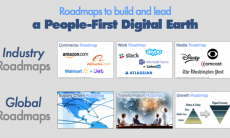Why do some companies seem to rely on their brand as the sole value, while others are able make headlines for all the right reasons? Why do some companies look like they are stuck in the past, and others are shaping the way to the future? Nowadays, one of the most frequently used buzzwords is the word transformation. Everybody has a plan to transform his business, while big companies aim to make the way they deliver services and products and how they interact with end customers more digitized and more consumer-oriented.
This increasing trend focuses on radically transforming a business denotes a growing awareness about how society has been evolving and has been affected by innovation coming from different areas, such as the technological and digital fields. This is something prosperous only if it takes place the right way. Companies are used to spend too much time on planning. Most of the time, everything happens in a rigid, linear way, 18-24 months ahead of the implementation. Therefore, the expensive strategies that have been developed in the past for future implementations use tools and approaches that are outdated the moment they have to be implemented. In our fast-paced times, everything has to be adaptive and agile, easy to absorb knowledge. Everything must be constantly learning and efficiently deliver prototypes and ready to be implemented ideas in really short time frames. Change is a fast-paced process that needs a constant probing-for-failure attitude. It needs the awareness that fast, incremental changes are more effective than a slow transformation that delivers present needs later on, without sufficient awareness of the ever-changing context organisations are operating.
Digital transformation might be the most ambitious project for most of the companies nowadays, and it is also the most challenging one. Transforming business and the customer experience and understanding customer drop-offs on well-designed-on-paper customer journeys is a tango that takes two: both the brand and the customers.
Collaboration is needed, in depth research becomes mandatory, internal and external conversation and dialogues are required, together with the ability to listen to user and business needs. Transformation is a process that happens here and now, through a constant iteration and interaction between the brand and its customers. There is not a silver bullet but hundreds of small steps to be fine tuned in order to create a customer journey without drop-offs which can provide a frictionless experience to the user and enhance their engagement with the brand.
All these steps should be based on a lean approach and be able to adjust, in real time, the strategy to the environment and the context. These steps have to measure the impact of it and make sure that it is not only correct one but also the most well-performing one. To achieve that agile way of work an adaptive digital cell is necessary. Pods will allow you to run the digital audit quickly and in-depth. You can start doing things better and differently in order to make sure that digital transformation is not just another word for your organization, but a living, fast-paced approach capable of putting you into the winners’ circle.






